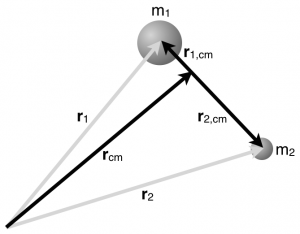This is an old revision of the document!
Formal derivation of Ktrans and Krel
In the notes, you will read about the formal derivation to separate the total kinetic energy into a translational component that tracks the energy associated with the motion of the center of mass, and the relative component that that tracks the energy of due to the motion relative to the center of mass.
Begin by considering two particles, one of mass m1 at location →r1 measured relative to some fixed coordinate axes and the other of mass m2 at location →r2 measured relative to the same coordinate axes. Both of these vectors positions are indicated with grey arrows.
For these two particles, we could determine their center of mass,
→rcm=m1→r1+m2→r2m1+m2
which is indicated by a black arrow, and then measure their positions relative to the center of mass (→r1,cm and →r2,cm, also black arrows in the figure). The location of each particle can be related to these vectors,
→r1=→rcm+→r1,cm→r2=→rcm+→r2,cm
